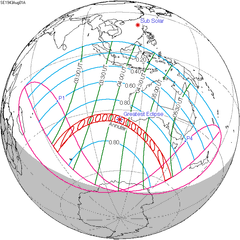August 1952 lunar eclipse
Appearance
| Partial eclipse | |||||||||||||
| Date | August 5, 1952 | ||||||||||||
|---|---|---|---|---|---|---|---|---|---|---|---|---|---|
| Gamma | −0.7383 | ||||||||||||
| Magnitude | 0.5317 | ||||||||||||
| Saros cycle | 118 (48 of 74) | ||||||||||||
| Partiality | 147 minutes and 10 seconds | ||||||||||||
| Penumbral | 278 minutes and 22 seconds | ||||||||||||
| |||||||||||||
A partial lunar eclipse took place on Tuesday, August 5, 1952. The Earth's shadow on the Moon was clearly visible in this eclipse, with 53.2% of the Moon in shadow; the partial eclipse lasted for 2 hours and 27 minutes. The Moon's apparent diameter was larger and Supermoon because the eclipse occurred only 45 minutes before perigee.[1]
Visibility
[edit]The partial eclipse was visible from Europe, Africa, Asia, and Australia, seen rising over eastern South America and Atlantic, and setting over Pacific.
Related lunar eclipses
[edit]Lunar year series
[edit]| Descending node | Ascending node | |||||
|---|---|---|---|---|---|---|
| Saros | Date viewing |
Type chart |
Saros | Date viewing |
Type chart | |
| 103 | 1951 Feb 21
|
Penumbral
|
108 | 1951 Aug 17
|
Penumbral
| |
| 113 | 1952 Feb 11
|
Partial
|
118 | 1952 Aug 5
|
Partial
| |
| 123 | 1953 Jan 29
|
Total
|
128 | 1953 Jul 26
|
Total
| |
| 133 | 1954 Jan 19
|
Total
|
138 | 1954 Jul 16
|
Partial
| |
| 143 | 1955 Jan 8
|
Penumbral
| ||||
| Last set | 1951 Mar 23 | Last set | 1951 Sep 15 | |||
| Next set | 1955 Nov 29 | Next set | 1955 Jun 5 | |||
Half-Saros cycle
[edit]A lunar eclipse will be preceded and followed by solar eclipses by 9 years and 5.5 days (a half saros).[2] This lunar eclipse is related to two annular solar eclipses of Solar Saros 125.
| August 1, 1943 | August 11, 1961 |
|---|---|

|

|
See also
[edit]Notes
[edit]- ^ Hermit Eclipse: Saros cycle 118
- ^ Mathematical Astronomy Morsels, Jean Meeus, p.110, Chapter 18, The half-saros
External links
[edit]- 1952 Aug 05 chart Eclipse Predictions by Fred Espenak, NASA/GSFC





